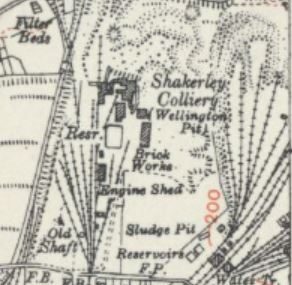

Wellington Pit 1947.[1]
Reproduced with the permission of the National Library of Scotland
Ramsden’s Shakerley Collieries was a coal-mining company operating from the mid-19th century in ShakerleySuburb of Tyldesley in Greater Manchester, anciently a hamlet in the northwest of the township., TyldesleyFormer industrial town in the Metropolitan Borough of Wigan, in Greater Manchester. on the Manchester Coalfield in Lancashire, England. The company owned two pits: the older, Messhing Trees was renamed Wellington Pit and Shakerley Colliery was renamed the Nelson Pit. The pits were amalgamated into Manchester CollieriesCoal mining company with headquarters in Walkden, Lancashire, formed in 1929 by the merger of a group of independent companies operating on the Manchester Coalfield. in the 1930s and closed soon after.
Geology
The Middle Coal Measures of the Manchester CoalfieldPart of the Lancashire Coalfield. Some easily accessible seams were worked on a small scale from the Middle Ages, and extensively from the beginning of the Industrial Revolution until the last quarter of the 20th century. were laid down in the Carboniferous period, and coal was mined from more than a dozen seams between the Crumbouke and Arley mines.[a]In this part of Lancashire a coal seam is referred to as a mine and the coal mine as a colliery or pit. The seams generally dip towards the south and west and are affected by small faults. The Upper Coal Measures are not worked in this part of the coalfield.[2]
History
Coal had been dug from out crops in Shakerley since the 15th century and a dispute over “seacole” was recorded in 1429.[3] Coal was used in the smithies of the nailers who plied their trade in the hamlet.Rural settlement smaller than a village. In 1836 Jacob Fletcher of Peel Hall in Little Hulton bought the Shakerley estate acquiring “514 acres of land, and the valuable mines of coal and stone lying under the same; the estates abounded with thriving young timber; the mines of coal were inexhaustible, of excellent quality, and being in a manufacturing district found a ready sale”.[4]
Messhing Trees, north of Manchester Road in Tyldesley, which was renamed the Wellington Pit, was started by William Ramsden.[5] It accessed the Trencherbone mine at 360 yards (329 m) and was ventilated by furnace. Coal to make gas and household coal was produced in 1896 from the Arley, Hell Hole, Trencherbone and Yard mines.[6]
Shakerley Colliery, which was renamed the Nelson Pit, was sunk in the 1830s or 1840s on land leased from Ellis Fletcher. It was worked by Nathan Eckersley and in 1861 passed to his nephew William Ramsden who owned Messhing Trees. In 1869 when Ramsden was sinking a shaft at the Nelson Pit he got into financial difficulties and disappeared after setting out to go the bank at Bolton. Ramsden’s wife was left behind to keep the collieries working and pay wages. She approached George Green of Yew Tree Colliery for help. Ramsden returned some weeks later arriving at one of his collieries having walked from Liverpool after returning from Ireland.[7]
A shaft was sunk to 840 feet to the Trencherbone mine and the pit produced house coal.[6] The colliery was renamed after 1880.[8] The shaft was deepened to the Arley mine at 1486 feet.[5] Ramsden’s pits joined Manchester Collieries in 1935. The Wellington Pit was abandoned in the same year and the Nelson Pit closed in 1938.[9]
Nelson Pit relied on road transport and a cobblestone toll road, Shakerley Lane, was built linking it to the Bolton to Leigh turnpike road near Green Hall in Atherton to the north.[8] Itremained a toll road until 1949 but is now a bridleway.
Disasters
DisastersMining disasters in Lancashire in which five or more people were killed occurred most frequently in the 1850s, 1860s and 1870s. at the Shakerley Pits included the death of six men when the cage rope broke at the Nelson Pit on 2 October 1883.[10][11] On 1 October 1895 five men including the colliery manager and undermanager died at the Wellington Pit after an explosion of firedampDamps is a collective name given to all gases other than air found in coal mines in Great Britain. The chief pollutants are carbon dioxide and methane, known as blackdamp and firedamp respectively. , possibly caused by a faulty Clanny safety lamp.[12]
Locomotives
After the London and North Western Railway built the Tyldesley LooplineRailway line built in 1864 to connect local collieries to the Liverpool–Manchester main line. in 1864, Ramsden built a railway to join the mainline at Ramsden’s Sidings east of the Tyldesley Coal CompanyCoal company was formed in 1870 in Tyldesley on the Manchester Coalfield, in the historic county of Lancashire, England. ‘s Green’s Sidings. In 1874 a 0-4-0 saddle tank locomotive “Shakerley” was bought from Manning Wardle and in 1887 “Edith” a 0-6-0 tank engine was bought from Hunslets. “Shakerley” was sold in 1901 and replaced by a new locomotive from Hunslets, identical to “Edith” which was also named “Shakerley”.[9]

